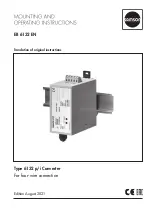
Inverter Specifications
Geting Star
ted
1–10
General
Specifications
The following table (continued on next page) applies to all SJ700
2
inverter models.
Item
General Specifications
Protective enclosure *1, *11
IP20 (NEMA 1); models -750xFU2 to -4000xFU2 is IP00
Control method
Line-to-line sine wave pulse-width modulation (PWM) control
Output frequency range *4
0.1 to 400 Hz
Frequency accuracy
Digital command: ± 0.01% of the maximum frequency
Analog command: ± 0.2% (at 25
°
C ± 10
°
C)
Frequency setting resolution
Digital: ± 0.01 Hz; Analog: (max. frequency)/4000, [O] terminal: 12-bit 0 to 10V;
[OI] terminal: 12-bit, 4-20mA; [O2] terminal: 12-bit –10 to +10V
Volt./Freq. characteristic *5
V/F optionally variable (30 to 400Hz base frequency), V/F control (constant torque,
reduced torque), sensorless vector control, 0-Hz-range sensorless vector control
Speed fluctuation
± 0.5% (sensorless vector control or 0-Hz range sensorless vector control)
Acceleration/deceleration time
0.01 to 3600 sec., (linear curve profiles, accel./decel. selection), two-stage accel./decel.
Starting Torque *6
200% at 0.3 Hz (SLV or 0Hz-range SLV), 150% at 0 Hz-range SLV, with motor one
frame size down)
For -750Hxx to -1500Hxx: 180% at 0.3Hz
150% at 0 Hz range with feedback board (with 0Hz-range sensorless vector control or
with motor one frame size down)
For -750Hxx to -1500Hxx: 130% at 0.3Hz
Carrier frequency range
Models -004xFU2 to -550xFU2: 0.5 to 15.0 kHz;
Models -750xFU2 to -1500xFU2: 0.5 to 10.0 kHz;
Models -1850HFU2 to -4000HFU2: 0.5 to 3.0 kHz
DC braking
Performs at start under set frequency at declaration, via an external input (braking force,
time, and operating frequency)
Overload capacity (output current)
150% for 60 seconds, 200% (180% for 75kW / 100HP and larger) for 0.5 seconds
Input
signal
Freq.
setting
Operator keypad
Up and Down keys / Value settings
Potentiometer
Analog setting via potentiometer on operator keypad
External signal *8
0 to 10 VDC and –10 to +10 VDC (input impedance 10k Ohms), 4 to 20 mA (input
impedance 250 Ohms), Potentiometer (1k to 2k Ohms, 2W)
Serial port
RS485 interface
FW/RV
Run
Operator panel
Run key / Stop key (change FW/RV by function command)
External signal
FW Run/Stop (NO contact), RV set by terminal assignment (NC/NO),
3-wire input available
Serial port
RS485 interface
Intelligent Input
terminals (assign eight
functions to terminals)
RV (reverse run/stop), CF1~CF4 (multi-speed select), JG (jogging), DB (external DC
braking), SET (set 2nd motor data), 2CH (2-stage accel./decel.), FRS (free-run stop),
EXT (external trip), USP (unattended start protection), CS (commercial power source),
SFT (software lock), AT (analog input voltage/current select), SET3 (set 3rd motor
data), RS (reset inverter), STA (start, 3-wire interface), STP (stop, 3-wire interface),
F/R (FW/RV 3-wire interface), PID (PID ON/OFF), PIDC (PID reset), CAS (control
gain setting), UP (remote control Up function, motorized speed pot.), DWN (remote
control Down function, motorized speed pot.), UDC (remote control data clearing),
OPE (Operator control), SF1-SF7 (Multispeed bits 0-7), OLR (Overload limit change),
TL (torque limit enable), TRQ1 (torque limit selection bit 1, LSB), TRQ2 (torque limit
selection bit 2, MSB), PPI (Proportional / Proportional/Integral mode selection), BOK
(Brake confirmation signal), ORT (Orientation – home search), LAC (LAC: LAD
cancel), PCLR (Position deviation reset), STAT (pulse train position command input
enable), ADD (trigger for frequency addition), F-TM (forcible-terminal operation),
ATR (permission of torque commend input), KHC (cumulative power clearance), SON
(servo ON), FOC (pre-excitation), MI1 (general-purpose input 1), MI2 (general-
purpose input 2), MI3 (general-purpose input 3), MI4 (general-purpose input 4), MI5
(general-purpose input 5), MI6 (general-purpose input 6), MI7 (general-purpose input
7), MI8 (general-purpose input 8), AHD (analog command holding), NO (not selected)
Thermistor input
One terminal (PTC characteristics)
















































